Until the Second World War, the dental students where I went to school (UCSF) used to spend the first two weeks of dental school down by the Bay at the U.C. Foundry making their own dental instruments. My class came along a generation later so we didn’t have to learn how to be blacksmiths in dental school but dentistry hadn’t changed much for the previous 100 years. Happily, high technology and material science at last have come to dentistry. As I enter my 36th year as a dentist, I did not imagine that I would be taking more classes, study clubs, and workshops than I did just out of dental school but that is how exciting the field has become. All the change has been for the better, too! I can enter all my treatment notes right at the chair. We take digital x-rays so there are no more toxic darkroom chemicals or waiting for film x-rays to develop. The digital x-rays use only one-third the radiation. I can send the digital x-rays to the insurance companies for pre-authorization with just a click. What’s not to like about that progress?
Digital dentistry also means digital impressions! We can use our 3D scanner to scan your mouth and teeth for a more accurate (and less messy) mold of the teeth. This allows the lab to design more accurate crowns (sometimes the same appointment) and bridges and we get them back faster.
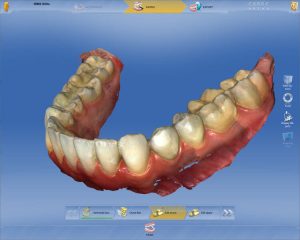

Aside from the digital revolution because of advances in materials science, the new dental materials are much easier to use and safer now too. The silver-mercury amalgam that had to be hand mixed and stuffed into a filling with a plunger is gone for good. None of us miss having to worry about mercury vapors around the office or in our patient’s mouths! Now we use composite resins that we can sculpt and harden on cue with a special lights.
For most adults, straightening their teeth no longer requires wearing hardware and rubber bands. Instead, another CAD/CAM breakthrough helps Dr. Benedict to design a series of (twenty to thirty) clear, plastic “aligners” which, when worn in their prescribed order by you for a couple of weeks or so, will progressively move your teeth to straighten your smile. It’s magic plastic with a determined memory. It takes about as long as traditional “braces” but compare 20-30 clear, plastic aligners (per arch) with traditional braces:
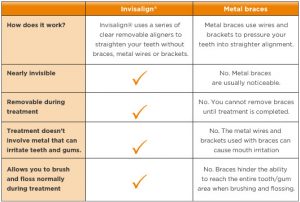
Of course, if you are not so much interested in the dental health benefits of improved, healthy arches and would rather go for a more attractive smile in the shortest time possible, then crowns and veneers can be employed for a relatively rapid cosmetic change. Dentists are not all that crazy for using crowns and veneers for cosmetic changes because most dentists love teeth and crowns and veneers require sacrificing some tooth so that the crown or veneer will adhere correctly. For example, when you decide on a veneer, the entire front surface of the tooth enamel is permanently removed. Then the veneer, a thin piece of specially-shaped porcelain or plastic, is glued over the front of your tooth. This is an irreversible procedure, since the tooth enamel is removed to accommodate the veneer. A crown preparation removes even more of the tooth.
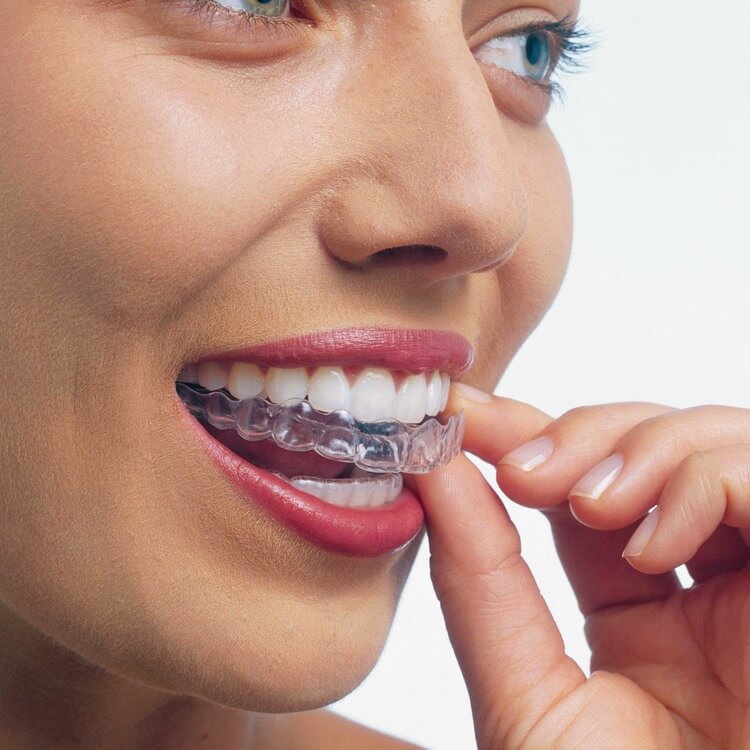
Another problem with veneers is that they are not a permanent solution. They can chip or break, requiring you to replace them on an individual basis, which can get pricey. Even if they don’t chip or break, over time they will come off. Veneers tend to last about 5 to 10 years, depending on the quality of the veneers purchased. Since your tooth enamel has been removed, most patients have no choice but to replace their veneers, incurring the same high costs every time they have to get a new set. Crowns last much longer, in fact, they should last the rest of your life if you take good care of your gums but they are more expensive.
When you combine the computer advances with the advances in materials science you get the CEREC®. It is for larger restorations (where a resin filling might not be strong enough to hold the tooth together safely). Don’t worry, if you just have to do it the old fashioned way, some teeth are still appropriately restored with gold or porcelain caps (dentists call them “crowns” because they sound more elegant!). Of course, the old fashioned way is using messy impression trays, casting up a plaster model (that you never saw), putting in a temporary restoration while we wait a few days for the crown to be made at the dental lab, prying off the temporary restoration, and then finally seating the finished crown.
The modern solution employs the CEREC and it is so cool that even my video game enthralled children sometimes stop by the office just to watch it work. It is a Computer Assisted Design/Computer Assisted Manufacturing (CAD/CAM) system that allows me to make 3-D images to record the dimensions of the tooth that will get the crown better than any sticky impression tray full of goop ever could. Then, instead of the dental lab, I carve the perfect restoration for your tooth (the perfect crown) on the computer. When I’m satisfied that it is just right (structurally, anatomically, and esthetically), I make a click or two and the CEREC actually carves (The CEREC engineers say “mills” because they think that term in more elegant!) the crown right there in the office. From the time that I start imaging your tooth until the finished crown is ready to seat in your mouth is about 30 minutes! Is that cool or what?
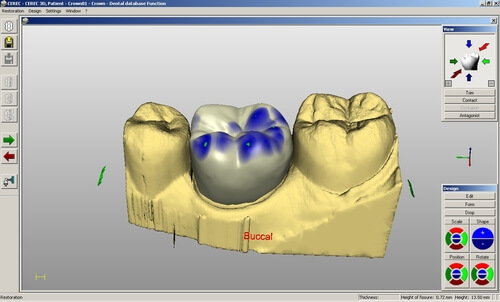
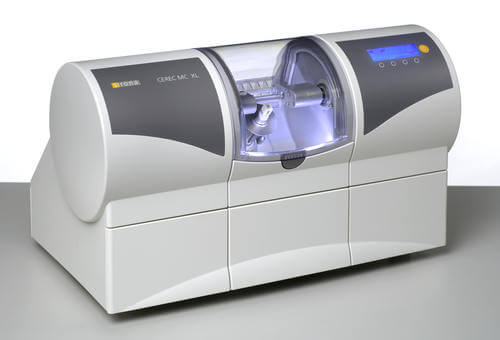
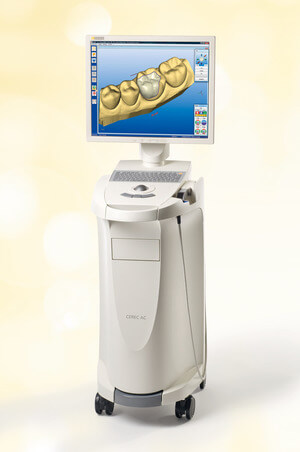
The CEREC system has been in development since 1980 so it is nothing experimental. If you are interested in the history of the development of CEREC, they feature a very interesting Flash presentation but before you play it, you must turn off your pop-up blockers. Also, it gets a little boring watching the company develop from 1980 on so you can skip ahead by moving the date indicator with your mouse to the year 2000 or so. Click Here to go to their website.
Our office is proud to offer cosmetic services including veneers, cosmetic crowns and full mouth rehabilitation.
Dental implants are artificial tooth roots that provide a permanent base for fixed, replacement teeth. Compared to dentures, bridges and crowns, dental implants are a popular and effective long-term solution for people who suffer from missing teeth, failing teeth or chronic dental problems. Because they fit, feel and function like natural teeth, dental implants are quickly becoming the new standard in tooth replacement.
What makes dental implants feel completely comfortable and secure? We use a medical-grade titanium implant that over time fuses to the living bone cells in the jaw. This forms a strong and durable anchor for your new teeth, meaning there’s no slippage or other movement (which can happen with dentures). There are also no problems eating with dental implants, no need to repair them regularly and no more worrying about smiling freely and openly.
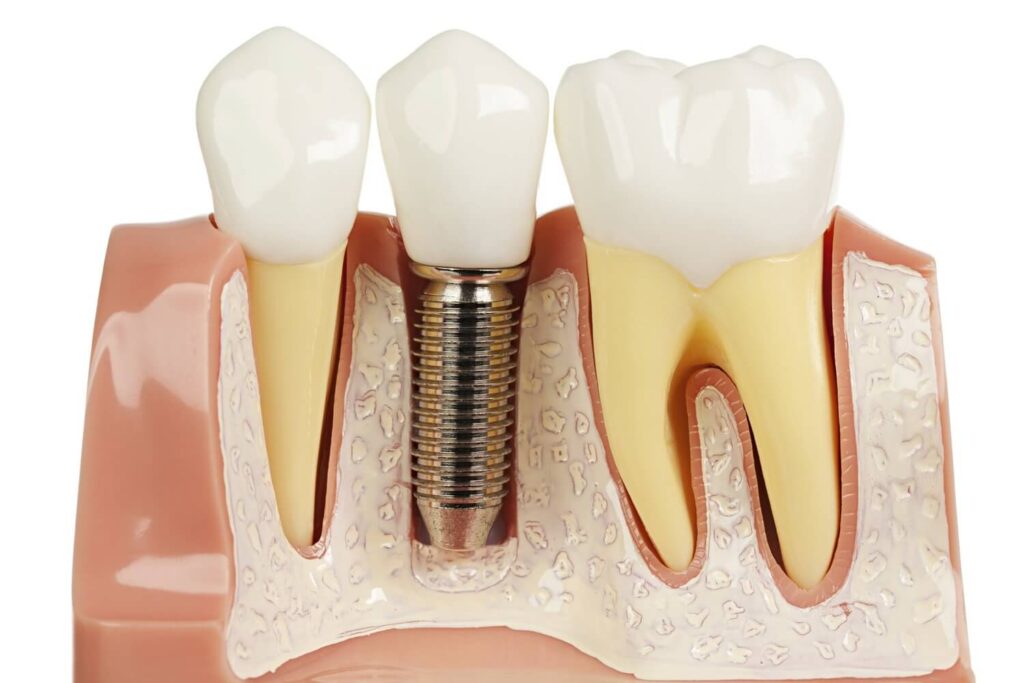
Dental implants typically have three parts:
1) The implant: A screw that serves as a root for your new teeth. This is what permanently attaches to your jaw.
2) The abutment: A permanent, but removable by your doctor, connector that supports and holds a tooth or set of teeth.
3) The crown (or prosthetic tooth): This is the part of the tooth that you can see. It’s usually made of zirconium or porcelain for durability and good looks.
You can use dental implants to replace a single tooth, multiple teeth or a full upper and/or lower set of teeth. If you need to restore a full set of teeth, you may be a perfect candidate for the all-on-four treatment. This is where we use four implants and then attach a full arch of teeth, giving the procedure its name (all teeth, only four implants). Give our office a call to find out more information.
The dental implant placement is performed in our office by either Dr. Gifford (the periodontist) or Dr. Bernhardt.
A root canal is a treatment used to repair and save a tooth that is badly decayed or becomes infected. During a root canal procedure, the nerve and pulp are removed and the inside of the tooth is cleaned and sealed. Without treatment, the tissue surrounding the tooth will become infected and abscesses may form.
We have a specialist (endodontist), Dr. San Filippo that performs root canals in our office. The endodontist will use a microscope and other special instruments to perform the procedure. It can usually be finished in one visit but occasionally will be two. Once completed, a crown will be placed on top of the tooth to prevent any fracture or leakage of bacteria back into the canal.
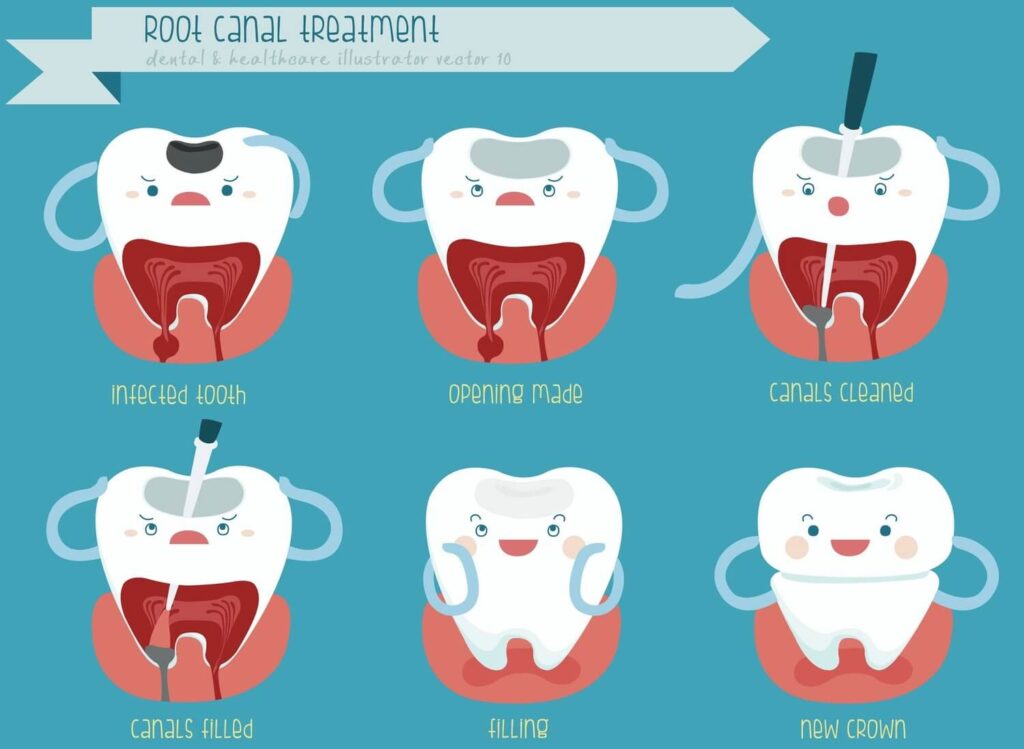
You make the best decisions when you have the best information. This is what Cone Beam allows us to do. Most dental imaging is in 2 dimensions, and for simple dental procedures that is adequate. However, more complicated procedures such as root canals and dental implants require better information. With implants, we can virtually plan and place the dental implant and know we are far away from important nerves (as shown below).
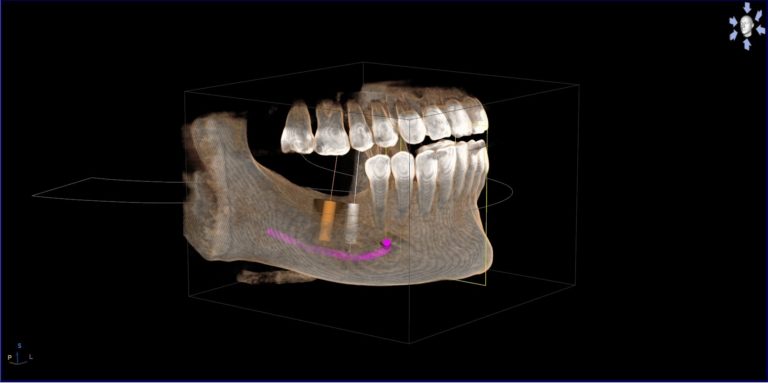
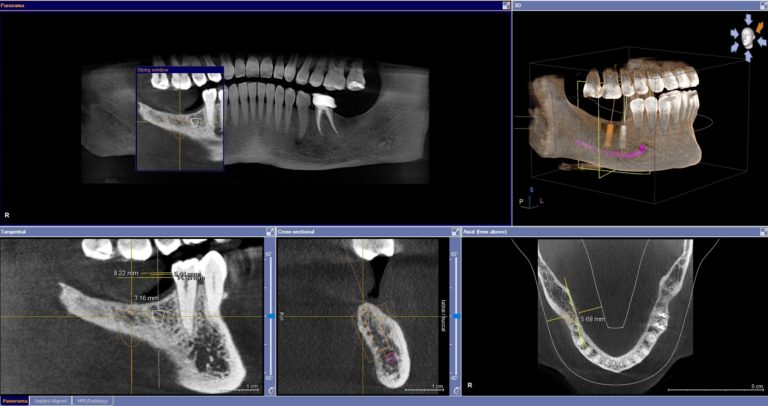
This technology also shows us to find hidden nerve canals inside teeth. This can make our root canals faster and more predictable. Cone beam technology is another tool we use to deliver better, safer and more predictable care.
You might’ve heard or seen some TV commercials promising viewers new teeth in one day.
Is it too good to be true?
The good news is that it’s not a myth. But the reality is that there is a lot of planning, as well as several visits, that go into preparing for that special “day.”
The “teeth in a day” cases usually refer to full arch dental implant restorations, in which all diseased teeth are removed, implants placed, and a temporary version of your teeth are placed—all in a single visit.
Several months later, after healing has occurred, the permanent teeth will be placed. This type of “dental makeover” can be a life-altering experience for patients who have previously had a lifetime of dental difficulty.
While most patients may not require removal of all their teeth, for those who do it is a tremendous service to be able to receive this type of treatment.
More commonly, patients may require replacement of a single front tooth. Single-visit implant placement that can be completed in one day is often an option that your dentist can discuss with you.
If you have missing teeth, deteriorating teeth, or have long-term dental issues, dental implants may be for you. Your next step is to schedule an appointment with a dental professional. It is important that you choose a dental implant expert, not just any dental practitioner.
Your health matters
When you meet with your implant dentist, you’ll undergo a complete dental exam (including X-rays and molds, or digital scans of your mouth). They will assess your individual situation and evaluate your teeth, gums, and bone structure prior to formulating a treatment plan. A 3-D X-ray will also be taken to help further evaluate your available bone.
After your implant treatment is completed, it’s especially important to maintain excellent oral hygiene and schedule regular dental visits. That way, you can make sure your dental implants last a lifetime.
When, and why, it can take longer than a day
Dental implant treatment involves both a surgical and restorative phase. In order for the dental implants to be successful, it requires the bone to heal around the implant.
It may also be necessary to prepare the site to accept a dental implant, which may require a few procedures.
After adequate healing has occurred, the restorative phase may begin. Depending upon the complexity of the case, this may be one to six months, or longer.
However, as noted before, there are cases when significant work is needed that the majority of the treatment is completed in a single surgical visit. These are the cases where all affected teeth are removed and an immediate temporary provided at the same time.
What to expect during surgery
Every patient is different and surgical protocols are custom-tailored to your specific needs.
For those patients undergoing the full arch “teeth in a day” procedures, you can expect to have all diseased teeth removed and leave the office with a temporary version of your new teeth that same day, and to return at a later date for placement of the final versions.
In a typical surgery, bad teeth (if present) are removed with the aid of a local anesthetic, bone grafts are placed as required, and the jawbone is prepared to accept the placement of your dental implant. Then the necessary amount of time is allowed for your implant to integrate, or fuse, to your jawbone.
Once healed, dentist will take molds or optical scans of your mouth to custom-make your artificial teeth. In a few short visits, you will enjoy the benefits and comfort of your new teeth.
Enjoying your new smile
Dental implants look and feel like natural teeth. Compared to dentures, it’s much easier to eat, smile, and talk with dental implants. You won’t have to worry about “clicking noises” or feel anxious about what food is “safe” to eat. You can stop feeling embarrassed by your smile and start living the way you want to.